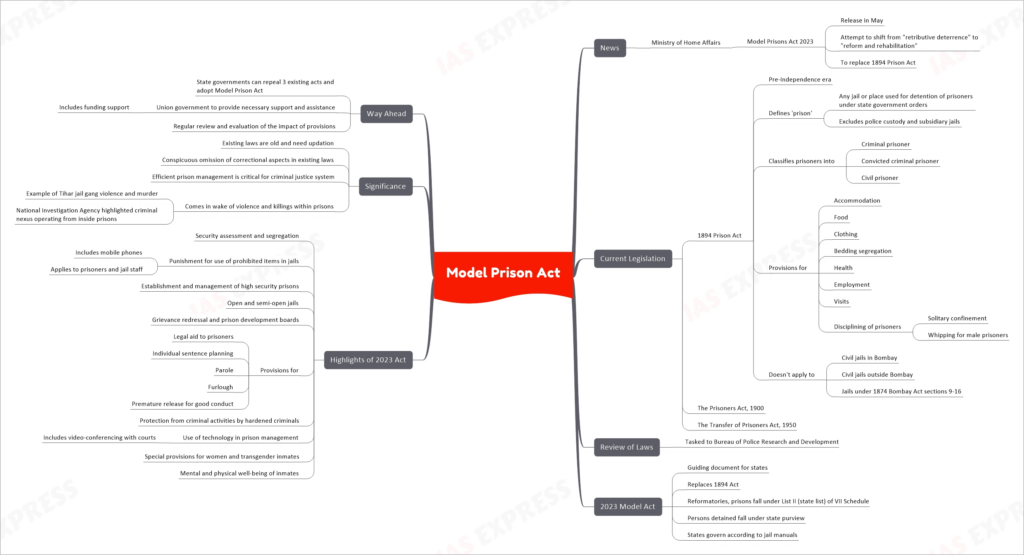Model Prison Act- Background, Highlights & Significance

From Current Affairs Notes for UPSC » Editorials & In-depths » This topic
IAS EXPRESS Vs UPSC Prelims 2024: 85+ questions reflected
In May, the Ministry of Home Affairs released the Model Prisons Act 2023 to overhaul prison administration in India. It is an attempt to shift away from “retributive deterrence” to “reform and rehabilitation”.
Background:
- Currently, the main law for prison administration is the 1894 Prison Act, a pre-Independence era legislation.
- The Act defines ‘prison’ as “any jail or place used permanently or temporarily under the general or special orders of a State Government for the detention of prisoners”. Hence it excluded police custody and subsidiary jails.
- It classified prisoners into 3 categories:
- Criminal prisoner
- Convicted criminal prisoner
- Civil prisoner
- It has provisions for:
- Accommodation
- Food
- Clothing
- Bedding segregation
- Health
- Employment
- Visits
- Disciplining of prisoners- including solitary confinement, whipping for male prisoners
- Note that this Act doesn’t apply to:
- Civil jails in the State of Bombay
- Civil jails outside the city of Bombay
- Jails under Sections 9–16 of the 1874 Bombay Act
- Two other laws cover this topic:
- The Prisoners Act, 1900
- The Transfer of Prisoners Act, 1950
- The Ministry of Home Affairs had tasked the Bureau of Police Research and Development (a government think tank on policing) to review these laws and frame a new draft.
- The 2023 Model Act seeks to replace the 1894 Act. It is to serve as a guiding document for the states.
- Note that prisons, reformatories, borstal institutions and other such institutions fall under the List II (state list) of the VII Schedule.
- Also, the persons detained in such institutions fall under state purview.
- Hence, states currently govern their prisons according to jail manuals.
Highlights:
- Provides for security assessment and segregation of prisoners.
- Use of prohibited items (eg: mobile phones) in jails will incur punishment not only for the prisoners, but also the jail staff.
- Provides for establishment and management of high security prisons, open and semi-open jails. It also provides for grievance redressal and prison development boards.
- Provides for
- Legal aid to prisoners
- Individual sentence planning
- Parole
- Furlough
- Premature release as an incentive for good conduct
- Provides for protection of the society from criminal activities by hardened criminals and habitual offenders.
- Provides for use of technology in prison management- such as video-conferencing with courts.
- Has special provisions for women and transgender inmates.
- Attention paid to mental and physical well-being of the inmates.
Significance:
- The existing 1894 law for prison is nearly 130 years old. The related laws are also decades-old and in dire need of updation.
- The Home Ministry highlighted the “conspicuous omission” of correctional aspects in the existing laws.
- Efficient prison management is critical for a well-functioning criminal justice system.
- The Model Act comes in the wake of a series of violence and killings within prisons- such as the recent gang violence and murder in Tihar jail. Also, the National Investigation Agency highlighted the presence of a “criminal nexus operating from inside prisons in Delhi, Punjab, Haryana, and Rajasthan.”
Way Ahead:
- The state governments can now repeal the 3 existing Acts in their jurisdictions and adopt the Model Prison Act as they see fit.
- The union government must provide the necessary support and assistance to the states in implementing the new law. This includes funding support.
- Following the enactment of these laws, regular review and evaluation of the impact of its provisions is necessary.
Conclusion:
The Indian incarceration system was put in place by the British with the original intention of subjugating political prisoners. Understandably, the 1894 Act is mainly focused on enforcing discipline, rather than reform. In line with the global change in perception of jails, the 2023 Model Act seeks to transform Indian prisons from “places of retributive deterrence” to “reformative and correctional institutions”.
Practice Question for Mains:
What are the shortcomings of the 1894 Prison Act that the new Model Act of 2023 can address? Discuss. (250 words)
If you like this post, please share your feedback in the comments section below so that we will upload more posts like this.


